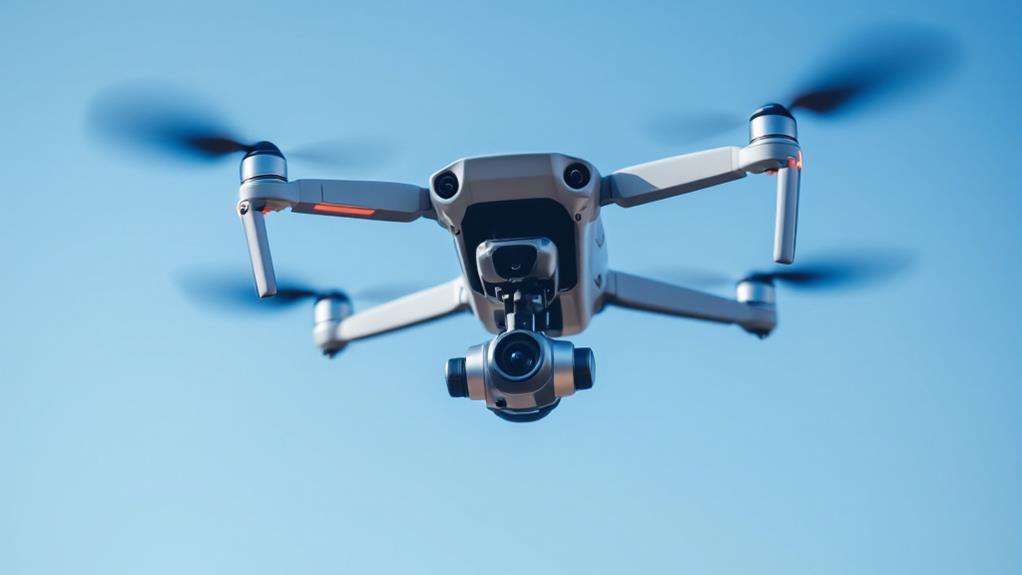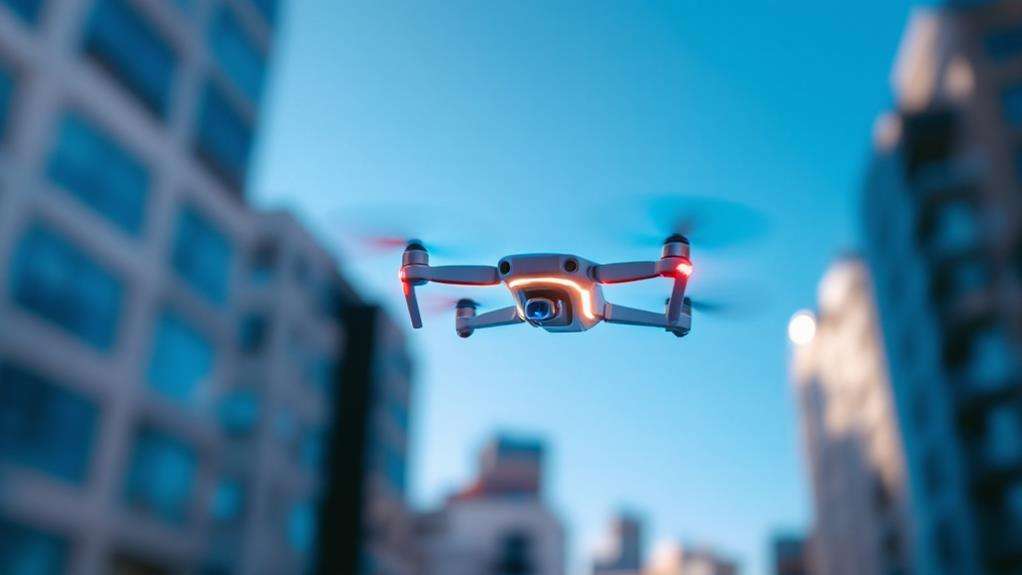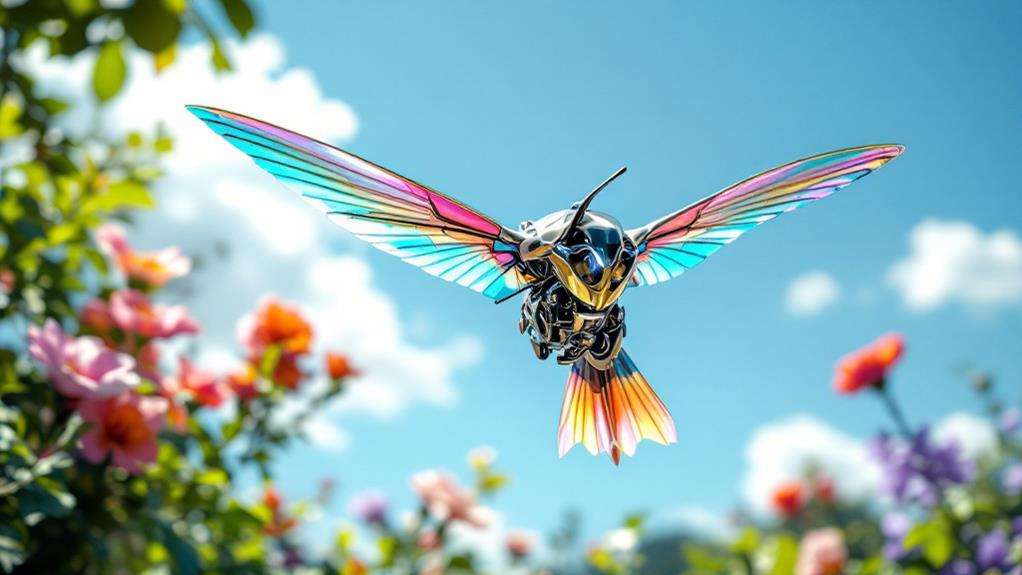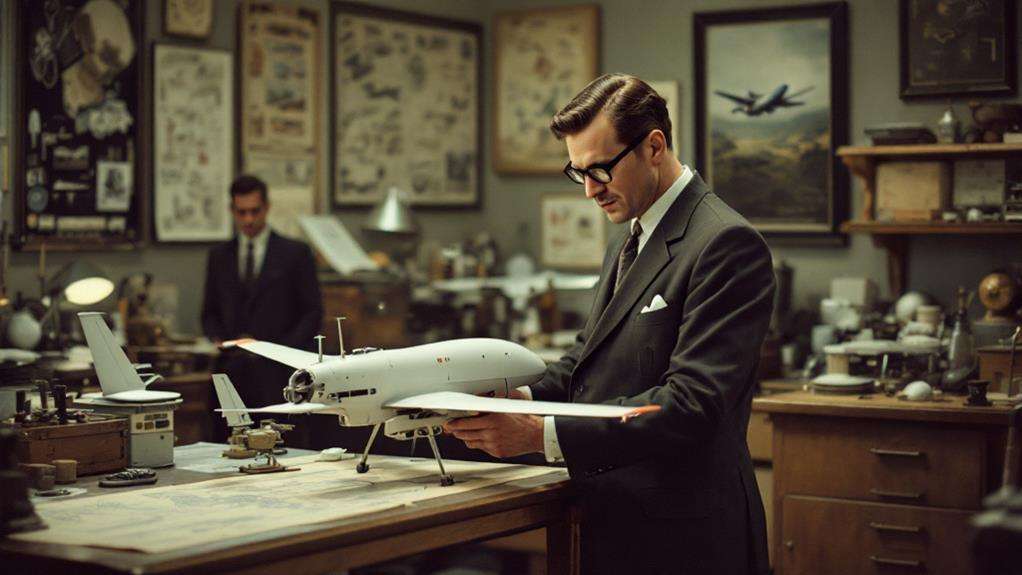What Is the Oldest Drone?
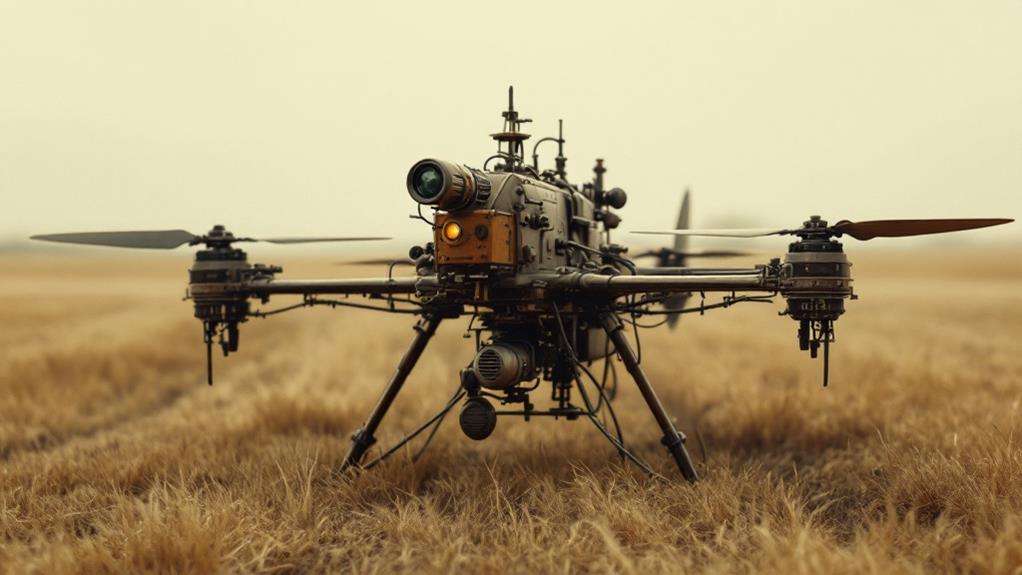
The Bréguet Quadcopter, crafted by Jacques and Louis Bréguet in 1907, is the oldest drone, marking the beginning of unmanned aerial flight. This early quadcopter could fly just about two feet off the ground, with the help of four stabilizing men. Although it wasn't as advanced as today's drones, its development laid the groundwork for future UAV technologies. Innovations didn't stop there, with advancements continuing through the World Wars and beyond. If you're curious about how these early steps evolved into today's cutting-edge drones, there's more to explore about this fascinating journey.
Key Takeaways
- The first recorded UAV use was in 1849 with incendiary balloons deployed over Venice.
- Geoffrey de Havilland's monoplane achieved the first successful radio-controlled flight in 1917.
- The Kettering Bug was introduced in 1918 as an early automated aerial torpedo.
- The British DH.82B Queen Bee, a radio-controlled target aircraft, coined the term "drone."
- The Bréguet Quadcopter, developed in 1907, is recognized as the first quadcopter.
Early Drone Concepts
The concept of unmanned aerial vehicles (UAVs) isn't as modern as you might think. The history of drones stretches back to the 19th century, with the oldest recorded use in July 1849 when Austrian forces launched incendiary balloons over Venice, marking an early instance of pilotless aerial technology. By World War I, innovation advanced with Geoffrey de Havilland's monoplane achieving the first successful flight of a radio-controlled aircraft on March 21, 1917. This milestone highlighted the potential of UAVs in military applications. Military drones have evolved significantly since then, now conducting reconnaissance and combat operations with enhanced operational efficiency. The Kettering Bug, introduced in October 1918, was among the earliest UAVs, designed as an aerial torpedo. Although it never saw combat, it represented a significant leap in the development of automated flight. As the inter-war period unfolded, the term "drone" began to take shape, notably through the British DH.82B Queen Bee, which functioned as a radio-controlled target aircraft. This era marked the evolution from simple pilotless machines to more sophisticated UAVs. During World War II, the Radioplane OQ-2 emerged as the first large-scale production drone, with nearly 15,000 units manufactured. Each advancement in UAV technology contributed to the growing potential for aerial photo reconnaissance and beyond.
The Bréguet Quadcopter
Consider the Bréguet Quadcopter, a groundbreaking creation by Jacques and Louis Bréguet in 1907, as a pivotal moment in UAV history. This remarkable invention is recognized as the first quadcopter and represents an early attempt to develop a stable, unmanned aerial vehicle. The Bréguet Quadcopter laid the foundation for UAV innovations, similar to those seen with the Austrian incendiary balloons in 1849 and the Kettering Bug in 1918. Despite its humble beginnings, the Bréguet Quadcopter marked a significant leap in early drone technology, setting the stage for future advancements.
During its initial flight, the Bréguet Quadcopter managed to reach only two feet off the ground. This might seem modest by today's standards, but at the time, it highlighted the immense challenges innovators faced. The aircraft required four men to stabilize it during flight, underscoring the difficulties in achieving balance and control in early designs. The involvement of Charles Richet, a controversial Nobel Prize winner, in its development further added to the project's historical significance.
The Bréguet Quadcopter's pioneering efforts were instrumental in laying the groundwork for modern quadcopter designs. Although it didn't achieve great heights, it influenced future developments in unmanned aerial vehicles, proving that the dream of flight could extend beyond manned aircraft. It's a testament to the vision and determination of the Bréguet brothers.
World War I Developments
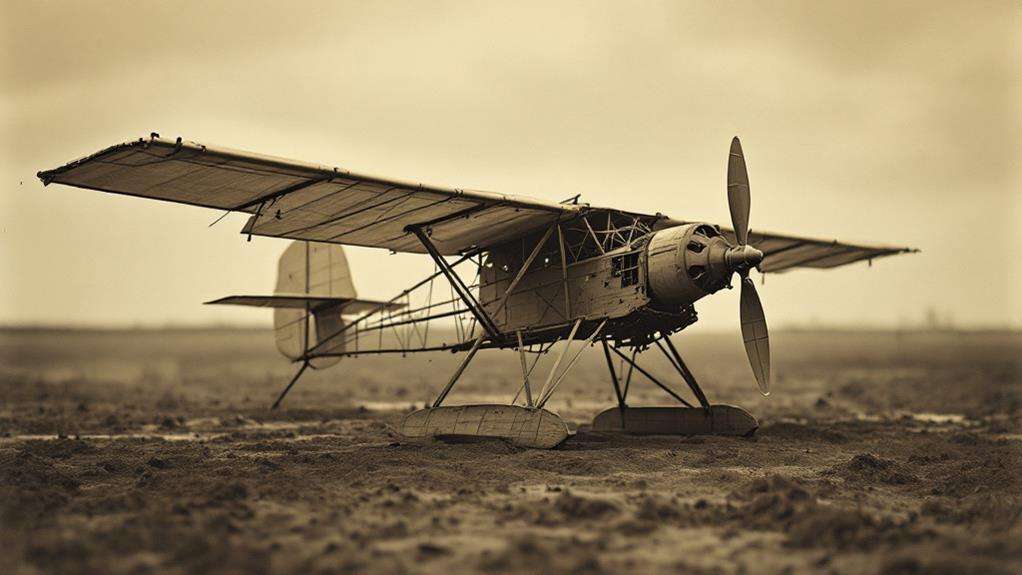
During World War I, the use of unmanned aerial vehicles (UAVs) marked a new era in military technology. The first recorded use of these UAVs occurred primarily for reconnaissance and training purposes. Britain's Aerial Target, tested in March 1917, represented the first controlled drone used in military applications. This innovation was a significant milestone, demonstrating how UAVs could change warfare.
Geoffrey de Havilland, a pioneer in aviation, developed a radio-controlled monoplane that successfully demonstrated controlled flight on March 21, 1917. This achievement showcased the early potential of UAVs, setting the stage for future advancements in drone technology. While Geoffrey de Havilland's monoplane was an impressive feat, it wasn't the only development during this period.
The American Kettering Bug, which first flew in October 1918, was another groundbreaking prototype. Designed as an aerial torpedo, it was a bold attempt to integrate UAVs into combat roles. However, despite its innovative design, the Kettering Bug was never deployed in combat.
Although the term "drone" originated later with the British DH.82B Queen Bee, these early efforts in World War I laid the groundwork for future UAV advancements.
Interwar Drone Innovations
Emerging from the shadows of World War I, the interwar years saw drone technology take significant strides forward. You'd be surprised at how much progress was made during this era, especially with the Royal Flying Corps leading the charge. The term "drone" itself originated from the British DH.82B Queen Bee model, which was developed in the 1930s as a radio-controlled target aircraft for military training. This period was marked by the development of unmanned aircraft, including the British Fairey Queen and the Airspeed Queen Wasp, which showcased groundbreaking innovations in drone technology.
Radio control became a key feature, enabling military drones to be more easily managed and effective for training purposes. The interwar period set the stage for future advancements, as small, fast, and easily controlled drones were developed. These innovations laid the groundwork for their extensive use in World War II. Additionally, Kálmán Tihanyi's invention of an early infrared-sensitive electronic television camera for UAVs in 1929 contributed to the evolution of drone capabilities.
World War II Impact
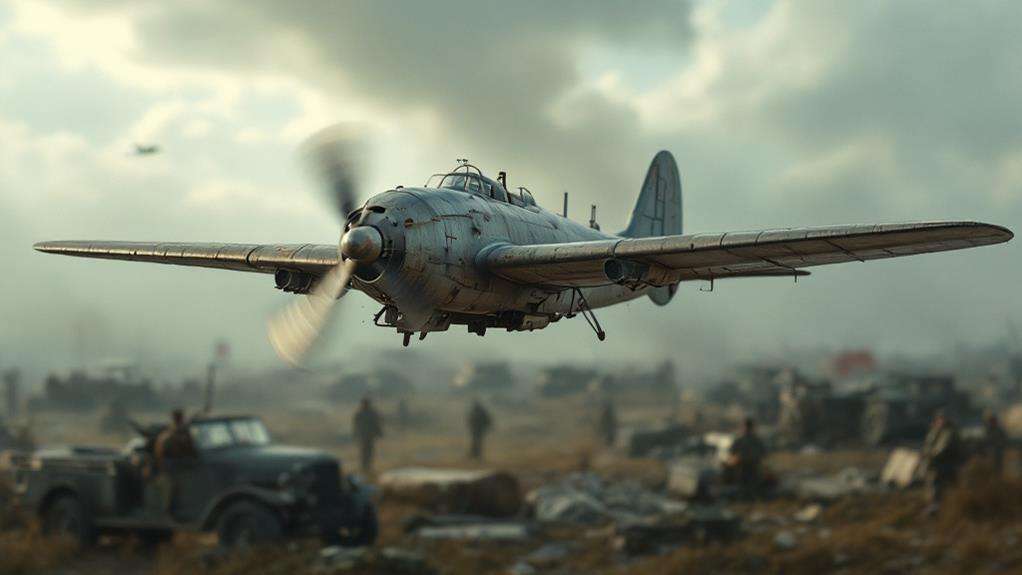
Building on the innovations of the interwar years, World War II marked a turning point for drone technology with its widespread and strategic applications. During this period, the first large-scale production drone, the Radioplane OQ-2, emerged as a critical tool for the U.S. Army. Developed by Reginald Denny, nearly 15,000 units of this unmanned aerial vehicle were manufactured. The Radioplane OQ-2 served primarily for target practice and training, introducing a new era where drones began to play a pivotal role in military tactics.
World War II also witnessed groundbreaking early combat applications of drones. Modified bombers, such as the B-17 and B-24, were transformed into aerial torpedoes for operations like Aphrodite. These innovations highlighted the potential of drones in combat scenarios, setting the stage for future advancements. While reconnaissance drones like the Ryan 147SC would later prove invaluable in conflicts such as the Vietnam War, the groundwork laid during World War II demonstrated the strategic value of unmanned aerial systems.
Ultimately, the era underscored drones' transformative impact and established a foundation for their evolution in subsequent conflicts, shaping the future of military technology.
Cold War Advancements
The Cold War era brought remarkable advancements in drone technology, transforming military strategies and capabilities. During this time, the Radioplane OQ-2 emerged as the first mass-produced UAV, with nearly 15,000 units manufactured for the U.S. Army. This marked a significant milestone in the history of unmanned aerial vehicles, or UAVs, setting the stage for future innovations. The MQM-57 Falconer became the first drone specifically designed for battlefield reconnaissance, providing enhanced situational awareness and changing how military operations were conducted.
You can see how the development of the AQM-35 by Northrop showcased advancements in speed and capability for these remotely controlled vehicles. This turbojet-powered target drone could reach speeds of Mach 2, further illustrating the evolution of drone technology during this era. The McDonnell Douglas ADM-20 Quail, introduced as the first operational decoy drone, demonstrated the strategic use of UAVs to deceive enemy defenses.
Interestingly, drones were also used to collect radioactive data during nuclear tests in 1946, highlighting their early applications in gathering sensitive information. These Cold War advancements laid the groundwork for future drone programs, influencing their use even in conflicts like the Gulf War.
Modern Drone Evolution
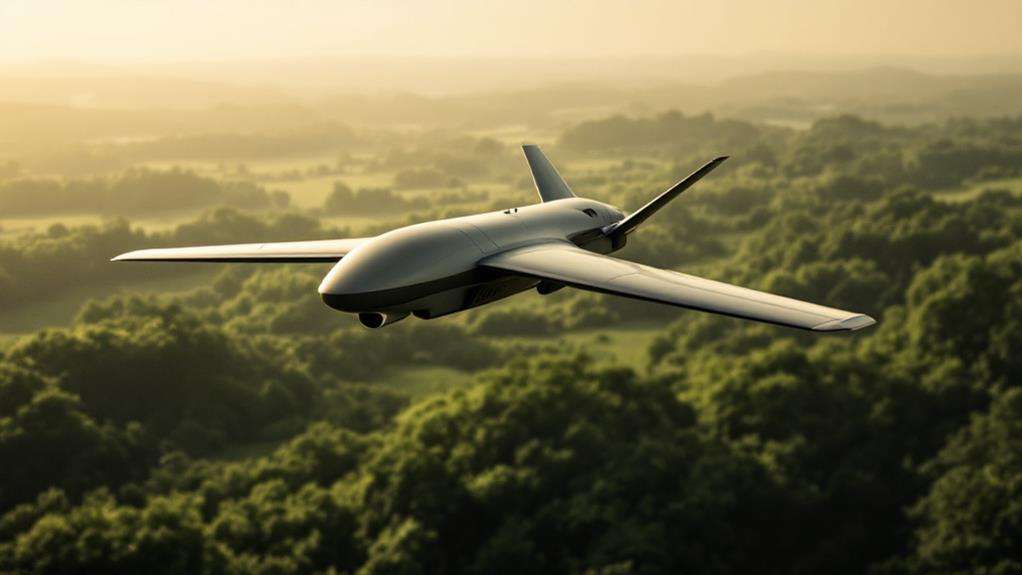
As the Cold War era set the stage for groundbreaking developments in UAV technology, the modern evolution of drones began taking shape in the 1970s and 1980s. During this period, advancements in remote control and GPS technology made unmanned aerial vehicles (UAVs) more precise and reliable. These innovations marked a new chapter in the history of unmanned aerial systems, pushing their potential beyond military uses.
The first significant shift towards commercial UAVs occurred in the early 2000s. The FAA began issuing permits for non-military applications, with the first commercial drone permit granted in 2006. This marked UAVs' inaugural entry into the commercial sector, paving the way for diverse applications, from aerial photography to agricultural monitoring.
Fast forward to 2016, DJI's Phantom 4 revolutionized consumer drone technology. Its first flight introduced advanced features like obstacle avoidance and intelligent tracking, setting new standards for aerial photography and videography.
The COVID-19 pandemic further accelerated drone adoption, showcasing their versatility in contactless delivery and public health monitoring. Ongoing research continues to expand drone capabilities, focusing on integrating artificial intelligence to enhance safety and efficiency across industries. This evolution illustrates how far UAVs have come since their early beginnings.
Ethical and Future Considerations
Many ethical dilemmas arise with the expanding use of drones, particularly in warfare. When unmanned aircraft are deployed, ethical considerations become paramount, especially given the civilian impact. You might find that the lack of transparency in military operations involving drone usage after 9/11 has sparked significant debate. Organizations like Airwars are crucial in highlighting these concerns, pushing for accountability and demanding that military actions meet humanitarian standards.
As drone technology advances, the conversation around regulation intensifies, particularly with the emergence of autonomous drones. The idea of machines making life-and-death decisions raises profound ethical questions. You have to consider whether the efficiency gained in combat outweighs potential humanitarian costs. There's a need for stringent international laws to govern the use of these technologies to ensure that ethical considerations aren't sidelined.
Looking to the future, it's clear that as drones become more sophisticated, continuous evaluation of ethical frameworks is essential. This ensures compliance with humanitarian standards and the protection of civilian lives in conflict zones. You must advocate for regulations that balance technological advancement with the moral imperatives of warfare, ensuring drones are used responsibly.

